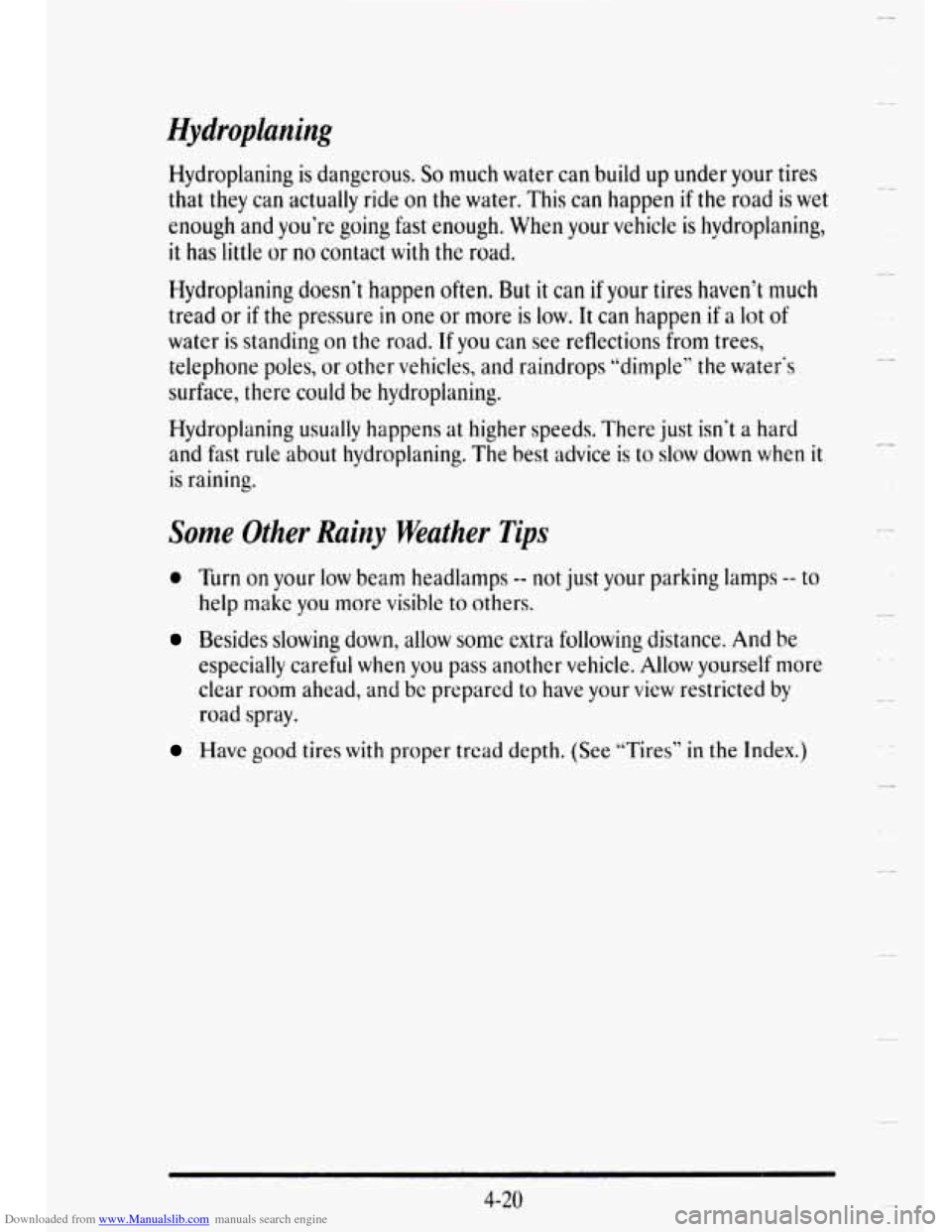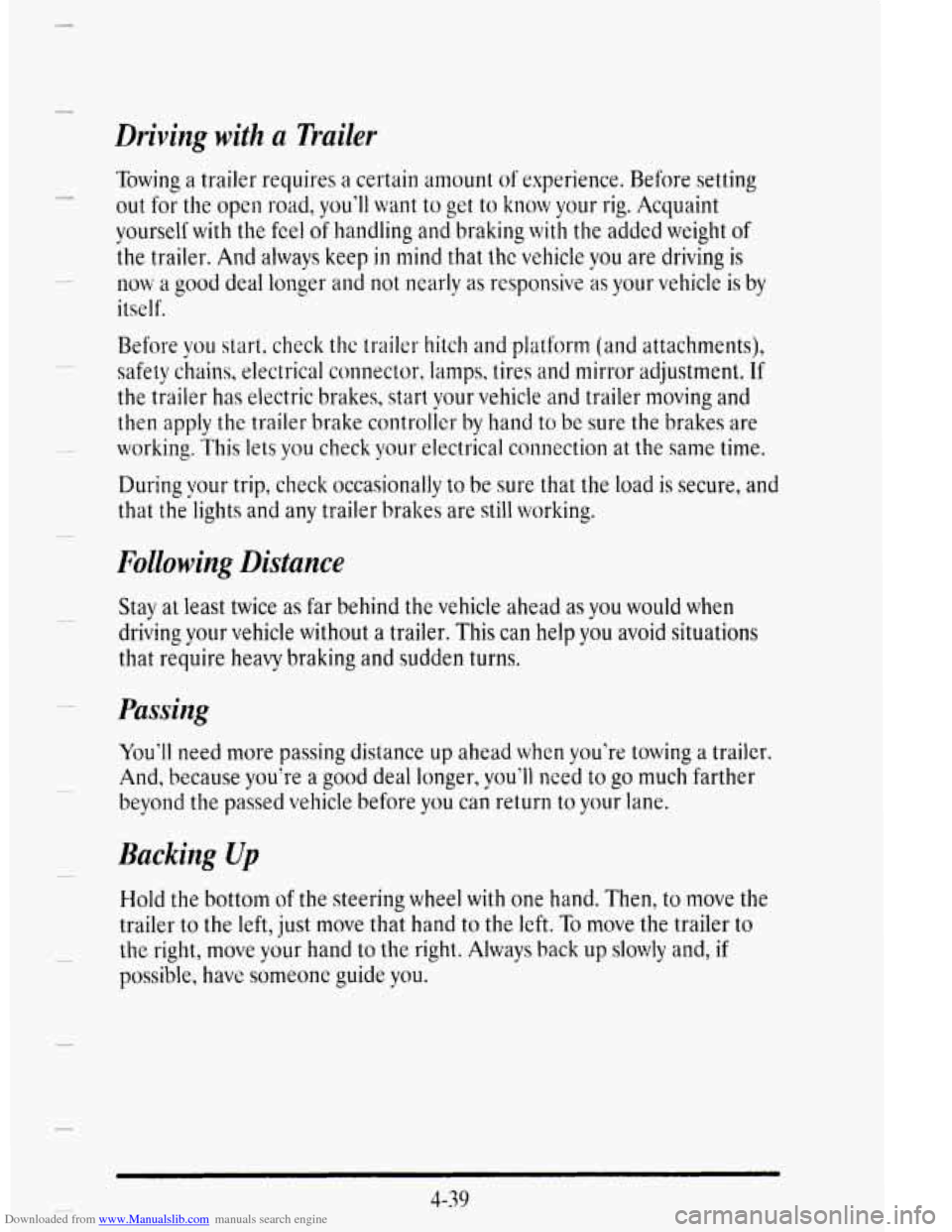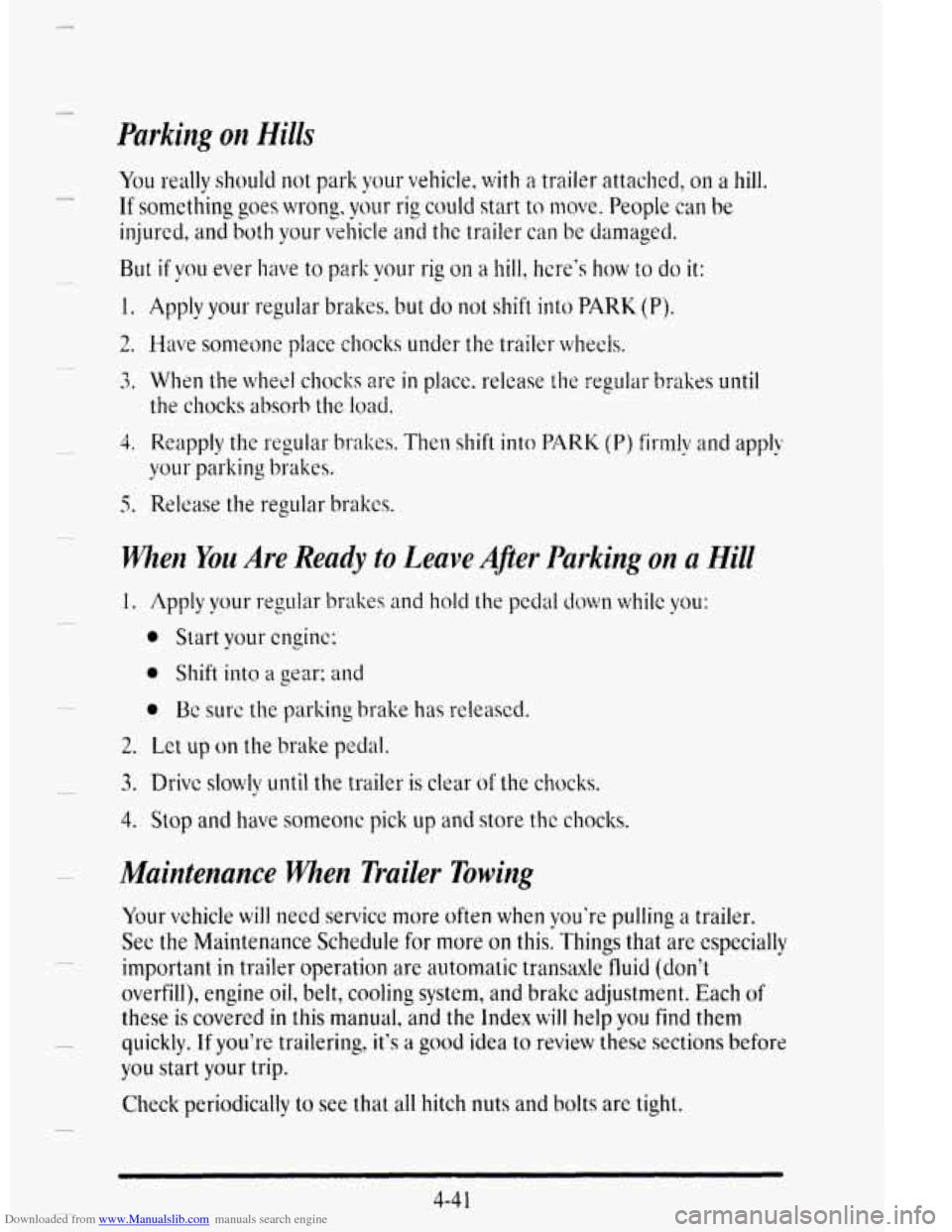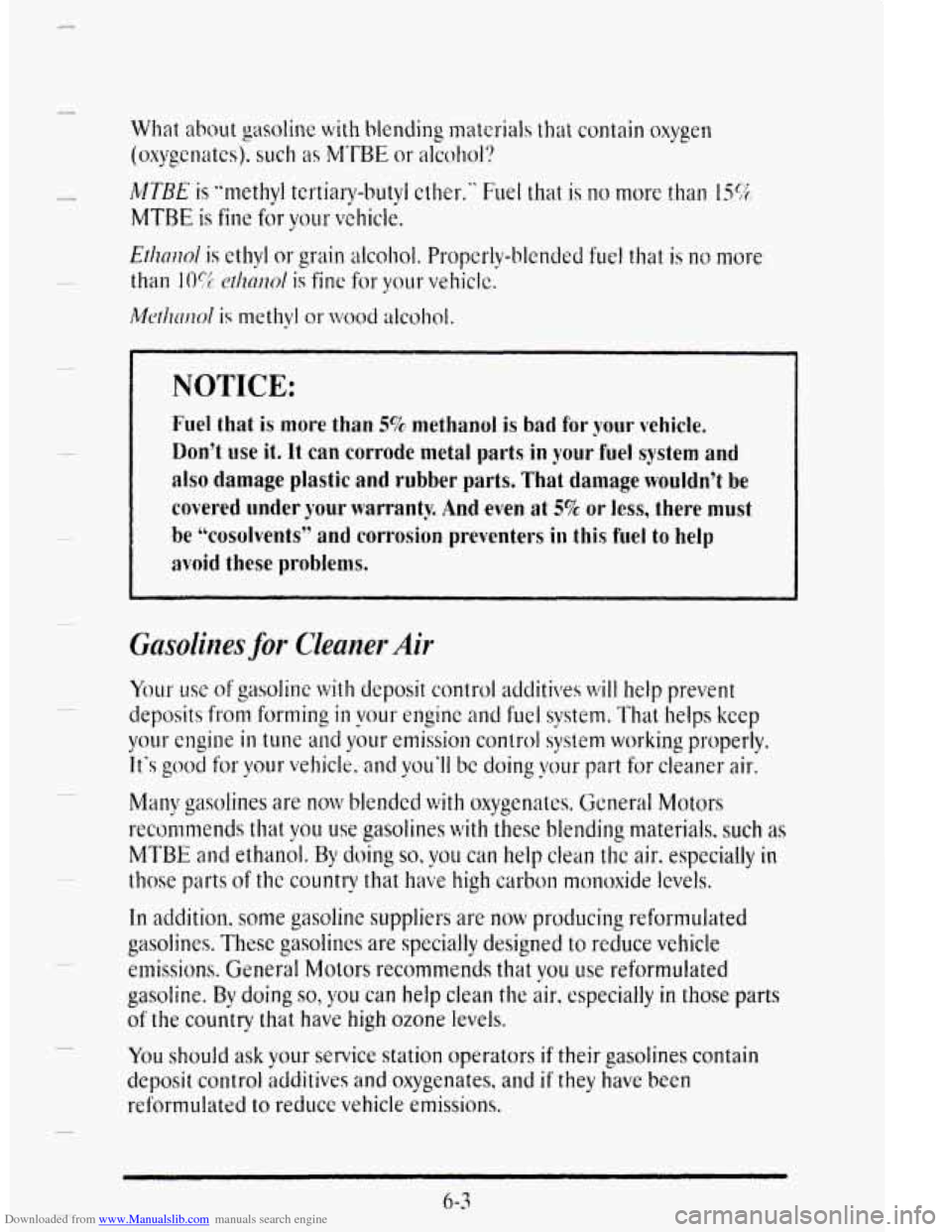ESP CADILLAC DEVILLE 1995 7.G User Guide
[x] Cancel search | Manufacturer: CADILLAC, Model Year: 1995, Model line: DEVILLE, Model: CADILLAC DEVILLE 1995 7.GPages: 403, PDF Size: 20.69 MB
Page 213 of 403

Downloaded from www.Manualslib.com manuals search engine Hydrupluning
Hydroplaning is dangerous. So much water can build up under your tires
that they can actually ride
on the water. This can happen if the road is wet
enough and you’re going fast enough. When your vehicle
is hydroplaning,
it has little or no contact with the road.
Hydroplaning doesn’t happen often. But it can if your tires haven‘t much
tread or
if the pressure in one or more is low. It can happen if a lot of
water
is standing on the road. If you can see reflections from trees,
telephone poles,
or other vehicles, and raindrops ‘‘dimple’‘ the water‘s
surface, there could be hydroplaning.
Hydroplaning
usually happens at higher speeds. There just isn‘t a hard
and fast
rule about hydroplaning. The best advice is to slow down when it
is raining.
Some Other Rainy Weather Tips
0 Turn on your low beam headlamps -- not just your parking lamps -- to
help
make you more visible to others.
Besides slowing down, allow some extra following distance. And be
especially careful when you pass another vehicle. Allow yourself more
clear
room ahead, and be prepared to have your view restricted by
road spray.
Have good tires with proper tread depth. (See “Tires” in the Index.)
4-20
Page 232 of 403

Downloaded from www.Manualslib.com manuals search engine Driving with a Trailer
Towing a trailer requires a certain amount of experience. Before setting
out for the open road, you’ll want to get to know your rig. Acquaint
yourself
with the feel of Ilandling and braking with the added weight of
the trailer. And always keep in mind that thc vehicle you are driving is
now a good deal longer and not nearly as responsivs as your vehicle is by
itself.
Before you start, check thc trailer hitch
and platform (and attachments),
safety chains, electrical connector, lamps, tires
and mirror adjustment. If
the trailer has electric brakes, start your vehicle and trailer moving and
then apply the trailer brake controlier by hand
to be sure the brakes are
working.
This lets you check your electrical connection at the same time.
During \Tour trip, check occasionally to
be sure that the load is secure, and
that the’lights and any trailer brakes are still working.
Following Distance
Stay at least twice as far behind the vehicle ahead as you would when
driving your vehicle without a trailer. This can help
you avoid situations
that require heavy braking and sudden turns.
Passing
You’ll need more passing distance up ahead when you’re towing a trailer.
And, because you‘re a good deal longer,
you’ll need to go much farther
beyond
the passed vehicle before you can return to your lane.
Bucking Up
Hold the bottom of the steering wheel with one hand. Then, to move the
trailer
to the left, just move that hand to the left. To move the trailer to
the right, move your hand to the right. Always back up slowly and, if
possible, havc someone guide you.
4-39
Page 234 of 403

Downloaded from www.Manualslib.com manuals search engine Parking on Hills
You really should not park your vehicle, with a trailer attached, on a hill.
If something goes wrong, y&r riq could start to move. People can be
injured, and
both your vel;icle and the trailer can be darnagecl.
L.
But if you ever have to park your rig on a hill, here‘s how to do it:
1. Apply your regular brakes, but do not shift into PARK (P).
2. ILiave sonleone place chocks under the trailer whecls.
Wzen You Are Ready to Leave A@r Parking on n Hill
3
2. Let up on the brake pedal.
3. Drivc slowly until the trailer is clear of the chocks.
4. Stop and have someone pick up and store the chocks.
Maintenance when Trailer Towing
Your vehicle will need service more often when you’re pulling a trailer.
See the Maintenance Schedule for more on this. Things that are especially
important
in trailer operation are automatic transaxle fluid (don’t
overfill), engine
oil, belt, cooling system, and brake adjustment. Each of
these is covered in this manual, and the Index will help you find them
quickly.
If you’re trailering, it’s a good idea to review these sections before
you start your trip.
Check periodically
to see that all hitch nuts and bolts are tight.
4-4 1
Page 272 of 403

Downloaded from www.Manualslib.com manuals search engine What about gasoline with blending materials that contain oxygen
(oxygenates). such as MTBE or alcohol?
MTBE is ”nlethyl tcl-tiary-butyl ether. Fuel that is 11o more ttlan 15%
MTRE is fine for your vehicle.
Etimol is ethyl or grain alcohol. Propcriy-blended fuel that is no more
than 10% ctizwtol is fine for your velliclc.
“clurmd is methyl or wood alcohol.
.,
Fuel that is more than 5% methanol is bad for your vehicle.
Don’t
use it. It can corrode metal parts in your fuel system and
also damage plastic and rubber parts. That damage wouldn’t be
covered
under your warranty And even at 5% or less, there must
be “cosolvents” and corrosion preventers in this fuel to help
avoid these problems.
G~lsoiines for Cleaner Air
Your use of gasoline with deposit control additives will help prevent
deposits from forming
ill vour engine and fuel s\jstern. That helps keep
your engine L. in tune a11d your emission control $stem working properly.
It‘s good for your vehicle. and you‘ll bc doing vour part for cleaner air.
Many gasolines are now blended with oxygenates. General Motors
recommends that YOU us2 gasolines with these blending materials. such as
MTBE and ethanol. By doing so. you can help clean the air, especially in
those parts of the county that have high carbon monoxide levels.
In addition. some gasoline suppliers are mv producing reformulated
gasolines. These gasoiirm are speciallv designed to reduce vehicle
emissions. General
Motors recornrnshs that you use reformulated
gasoline. By doing so, you can help clean the air, especially in those parts
of the country that have high ozone levels.
You should ask your service station operators if their gasolines contain
deposit control additives and oxygenates,
and if they have been
reformulated
to reduce vehicle emissions.
L-
Lr
6-3
Page 288 of 403

Downloaded from www.Manualslib.com manuals search engine 3. Check both sides
of the dipstick, and
read the lower
level. The fluid
level must be in
the cross-hatched
i! rc2 *
4.
i
r
i
i
How to Add Fluid
F I
i
Pull out the dipstick. i.
2. r Using a long-neck funne'l. add enough fluid at the dipstick hole, tc
briniit to tie proper level. It doesn't take much fluid, generally less
than a pint (0.X). Do11 'r 01~~1fill. We recommend you ise only fluid
labeled
DEXRON."-III. because fluid with that label is ma&
especially for your automatic transaxle. Damage caused bv fluid other
than
DE~RON'~-III is not covered by your nLw ve~e wdarrantp.
i
Ir
0 After adding fluid, recheck the fluid level as described under "How to
Check."
When the correct fluid level is obtained, push the dipstick back in all
the way.
6-19
n
Page 355 of 403

Downloaded from www.Manualslib.com manuals search engine Who Will Repair Your Cadillac At Roadside ? ? ?
In many cases, the advisor at the Roadside Service Center can provide
instructions
to get you back on the road.
To resohe more complex problems, the advisor will page an experienced
Cadillac dealership Service Technician. The technician will call
you and
evaluate the possible cause. If a roadside repair is possible, the technician
will come to your location and provide a permanent or temporary repair.
What If Your Cadillac Is In An Unsafe Location Or
On A Limited Access Highway ? ? ?
If your car is located in an area that is determined to be unsafe (by you, the
advisor or the technician) or if the vehicle is on a limited access freeway or
regulated highway, the advisor will arrange to tow your Cadillac to a safe
location, where service can be performed. Additional assistance
will be
provided if necessary.
What If Your Cadillac Cannot Be Repaired
At Roadside ? ? ?
If your car cannot be repaired at roadside within a reasonable period of
time (approximately 45 minutes) or requires the resources of a Cadillac
dealership service facility, the advisor
will arrange a tow service for you.
Towing may also be necessary after the technician has attempted
a repair,
but determines that your car cannot be repaired
at roadside.
Tow services are provided by independent companies, so therefore,
Cadillac
is not responsible for the tow company. During the 48 months, or
50,000 miles/80,000 kilometers warranty period, towing services are
covered
for any disablement.
6
Page 364 of 403

Downloaded from www.Manualslib.com manuals search engine Owner Responsibilities
There are only two things which you will be responsible for during the
use of your courtesy vehicle. You are required to provide insurance
coverage and replenish the fuel used.
In many cases your own auto insurance policy may provide primary
coverage for the courtesy vehicle.
similar to rental car agreements.
Please. check
with your insurance cornpany to be certain what's covered.
i
.-
.. .
Gold Key Courtesy Transportation -- Jmt one more wy your Cadillac
Dealer is committed to you.
3-5
Page 368 of 403

Downloaded from www.Manualslib.com manuals search engine Y
Here you will find out how to contact Cadillac if you need assistance. This
section also tells you how to obtain service puhlications and how to report
any safety defects.
This section includes information on: Thc Customer Satisfaction
Procedure, Customer Assistance for Hearing or Speech Impaired, BBB
Auto Line - Alternative Dispute Resolution Program, Reporting Safety
Defects, Roadside Assistance, and Service and Owner Publications.
SATISFAC
Your satisfaction and goodwill are important to your dealer and Cadillac.
Normally, any concern
with the sales transaction or the operation of your
vehicle will be resolved by your dealer's Sales or Service Departmenk
Sometimes, however, despite the
best intentions of all concerned,
misunderstandillgs can occur.
If your concern has not been resolved to
pour satisfaction,
the following steps should be taken:
STEP ONE -- Discuss your concern with a member of dcaler
management. Normally, concerns can be quickly resolved at that level. If
the matter has already been reviewed
with the Sales, Service, or Parts
Manager, contact
the owner of the dealer or the General Manager.
STEP TWO -- If after contacting a member of dealer management, it
appears your concern cannot bcresolved by the dealer without further
help, contact
the Cadillac Consumer Relations Center 24 hours a day by
calling 1-800-458-8006. In Canada, contact GM of Canada Customer
Assistance Center
in Oshawa by calling 1-800-263-3777 (English) or
1-800-263-7854 (French).
In Mexico, call (525) 254-3777.
In Puerto Rico, call 1-800-496-9992
(English)
or 1-800-496-9993 (Spanish). In the U.S. Virgin Islands, call
1-800-496-9994. In other overseas locations, contact GM North American
Export
Sales in Canada by calling 1-905-644-4112.
1